Poached Salmon is the quickest, easiest, and sneakily swankiest way to cook salmon. It’s simply simmered until it reaches tender perfection—and it’s done in just 15 minutes!

Email Me the Recipe!
From time to time, we'll send you Well Plated emails. You can unsubscribe anytime. Have an account? Log In.
A quick, easy, and elegant main dish.

Poaching is a method of gentle cooking in which food is simmered in a liquid (water, broth, milk, or white wine).
This cooking method is ideal for foods that are prone to drying out, like eggs and poultry, in addition to poached salmon. (I use poaching in my post for How to Cook Shredded Chicken.)
- Poaching sounds pinkies-up fancy, but it’s simple and FAST—we’re talking 3 to 5 minutes for a single poached salmon fillet.
- Poaching is healthy too! Unlike Pan Seared Salmon or Baked Salmon, you don’t need any oil, and your salmon comes out nice and moist.
- Bonus! Poached salmon doesn’t leave any lingering odor in your kitchen, unlike other stovetop fish recipes like Blackened Salmon.
I love making poached salmon as a healthy weeknight dinner when I don’t have time for Instant Pot Salmon, but it’s also great to serve for a party and get a wow factor with less effort than Salmon Wellington or Stuffed Salmon.
5 Star Review
“I needed cooked salmon for another dish, looked up a poaching method, and found this one! It turned out SO GOOD.”
— Caitlin —
My Best Tips for Perfect Poaching
- Make It Your Own. I doctor my poaching liquid up with a little vinegar, honey, and lots of fresh dill. Feel free to experiment with other herbs and flavors like garlic cloves, onions, or leeks.
- Leave the Skin On. The skin helps keep the salmon intact while it poaches. You can easily remove it when the poached salmon is finished cooking.
- Know When It’s Done. Poached salmon cooks FAST so when in doubt, check early. Individual fillets will cook in as few as 3 minutes; a larger fillet will be ready in 15. The best way to know if salmon is done cooking is to use an instant read thermometer like this or this. Salmon is considered cooked at 145 degrees F. I remove mine at 135, then let it rest. The temperature will continue to rise as it sits.
- Remedying Dry Salmon. Your best bet if you overcook salmon is to cover it with a poached salmon sauce. Hollandaise is of course delicious with baked salmon and poached salmon alike. You also can drizzle it with browned butter, or a lemon butter sauce like the one on this Lemon Butter Chicken recipe.

Leftover Ideas
Use leftover poached salmon in this Salmon Salad instead of baking the fish. It makes a simple, delicious lunch, especially on a sandwich or served over a bed of spring greens!
What to Serve with Poached Salmon
- Roasted Vegetables. Roasted veggies are a delicious side dish for poached salmon. Try it with these Oven Roasted Vegetables or Roasted Fingerling Potatoes.
- Rice. Poached salmon with Lemon Rice would be scrumptious.
- Pasta. Pasta al Limone and salmon are a perfect match.
- Salad. Serve this salmon with Arugula Salad.

Poached Salmon
Video
Email Me the Recipe!
From time to time, we’ll send you Well Plated emails. You can unsubscribe anytime. Have an account? Log In.
Ingredients
- 2 tablespoons white vinegar
- 1 tablespoon honey
- 2 teaspoons kosher salt
- 4 (6-ounce) center cut salmon fillets skin on
- water
- 12 sprigs fresh dill plus additional chopped dill for serving
- 6 whole peppercorns
- 1 bay leaf
- Cracked black pepper and lemon wedges for serving
Instructions
- Fill a saute pan wide enough to hold the salmon in a single layer without overlapping the fillets and tall enough to cover the salmon with water about 1/4 of the way to the top. Add the vinegar, honey, and salt. Whisk to combine.
- Carefully lower the salmon fillets into the pan in a single layer. Add more water so that they are just barely covered.

- Scatter the dill, peppercorns, and bay leaf over the top.

- Bring the water to a gentle boil over medium-high heat. Simmer the salmon, adjusting the heat as needed so that you maintain a steady simmer but not a rapid boil. Let cook 2 minutes.

- Check the temperature of the salmon using an instant read thermometer. It should be around 135 to 140 degrees F, no more (fish is considered cooked at 145 degrees F, but the temperature will continue to rise as it rests). If needed, cook it 1 to 2 minutes more. DO NOT overcook or your salmon will be dry.
- With a wide spatula, gently lift the poached salmon out of the water and place it on a plate (discard the poaching liquid). Cover and let rest 4 minutes. Enjoy hot, sprinkled with additional chopped dill, cracked black pepper, and a squeeze of lemon as desired.
Notes
- TO STORE: Refrigerate salmon in an airtight storage container for up to 2 days.
- TO REHEAT: Very gently rewarm leftovers in a skillet on the stovetop over medium-low heat or in the microwave.
Nutrition
Email Me the Recipe!
From time to time, we’ll send you Well Plated emails. You can unsubscribe anytime. Have an account? Log In.

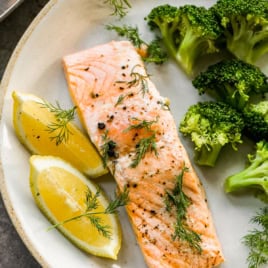



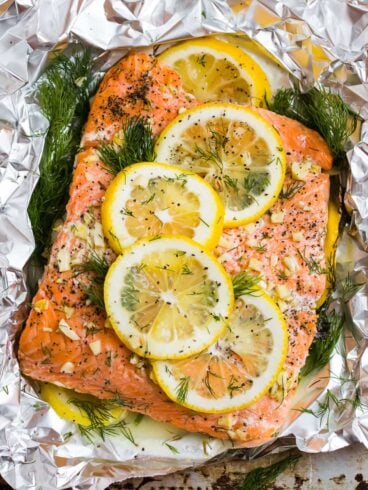
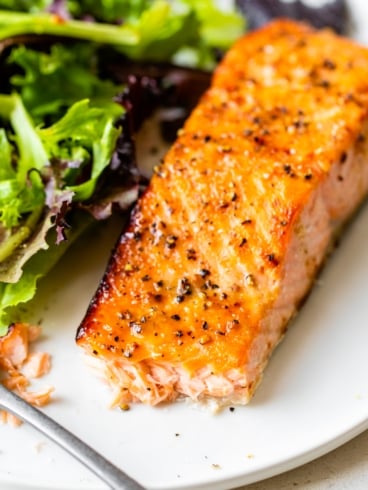
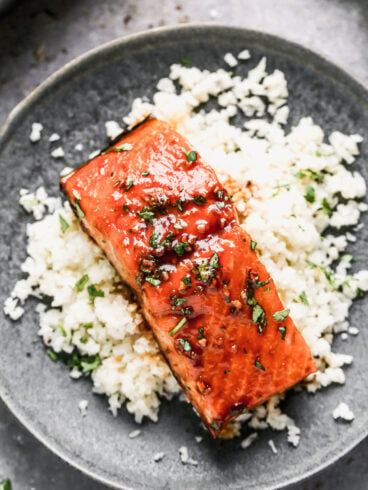

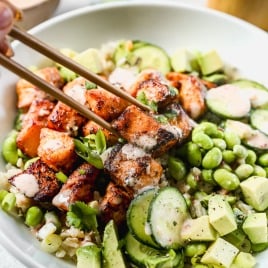

Hi. I don’t own a thermometer. I purchased one a few months ago, that never worked properly. So, what’s your advice about knowing if this is cooked. And, the recipe looks really good as well as a chance to use something other than wine or vermouth. Thanks.
Hi Joan! Salmon is finished when it flakes easily with a fork and is no longer dark pink inside. Note that it will cook a bit more as it rests.
Can’t wait to try, but what if my salmon is skinless, as frozen filets often are? Will it cook differently or fall apart? Also, have you tried poaching from frozen?
Hi David! I’ve only tested the recipe as written so I am afraid I can’t advise. Fish thaws quickly, so I’d recommend thawing it first. Let me know how it goes!
I needed cooked salmon for another dish, looked up a poaching method, and found this one! It turned out SO GOOD. My filets must’ve been thicker because they took 8 minutes and 10 minutes to get to 140.
Hi Caitlin! So glad you enjoyed the salmon! Thank you for this kind review!
Excellent! Needed a change and prefer poached.
Hi Lyla! So glad you enjoyed the recipe! Thank you for this kind review!
Excellent
Hi Frank! So glad you enjoyed the recipe! Thank you for this kind review!